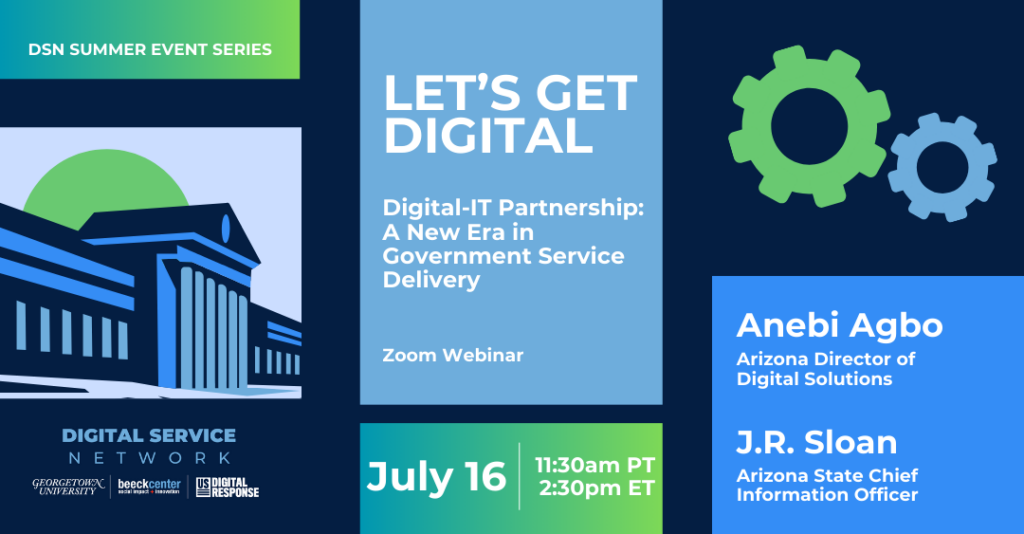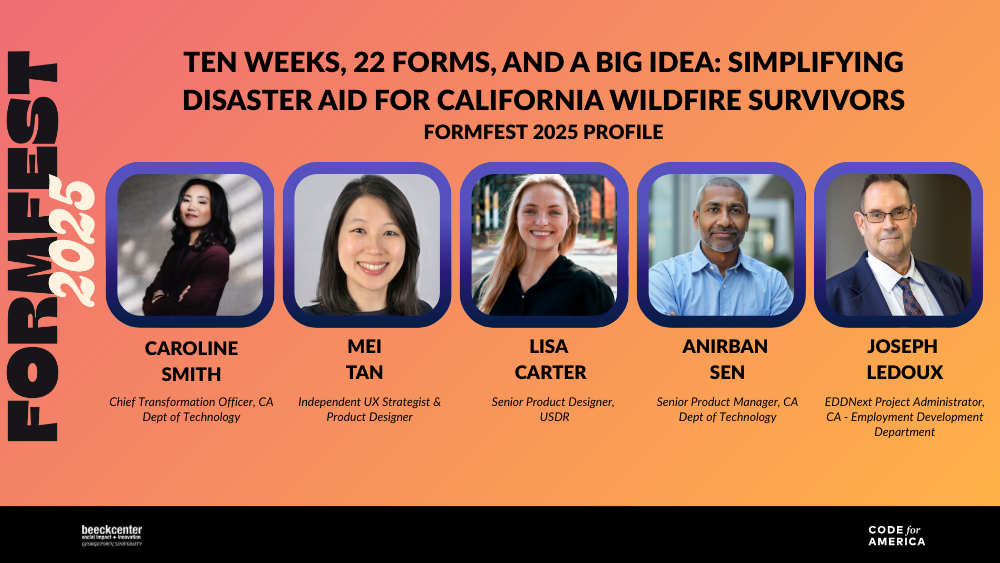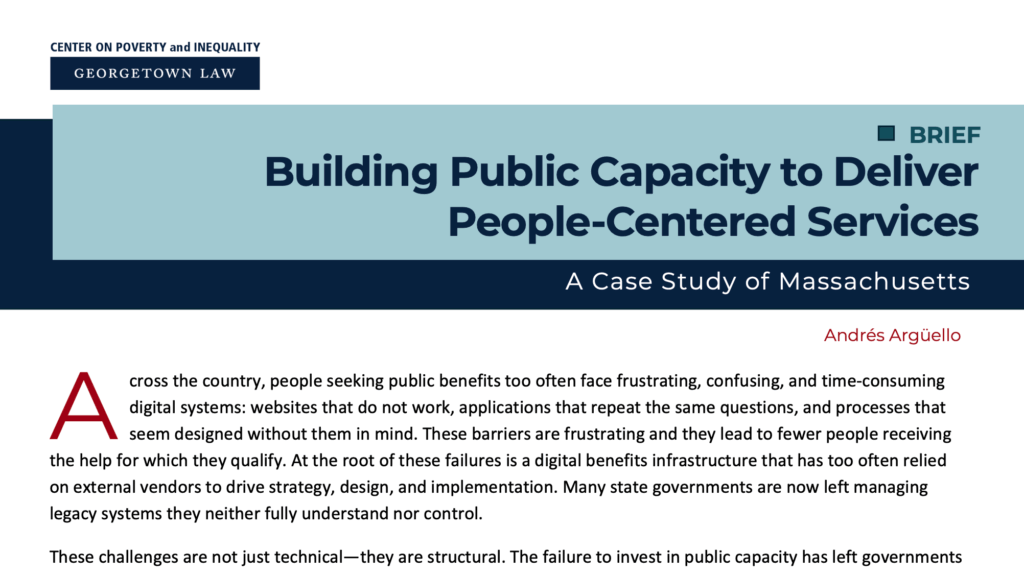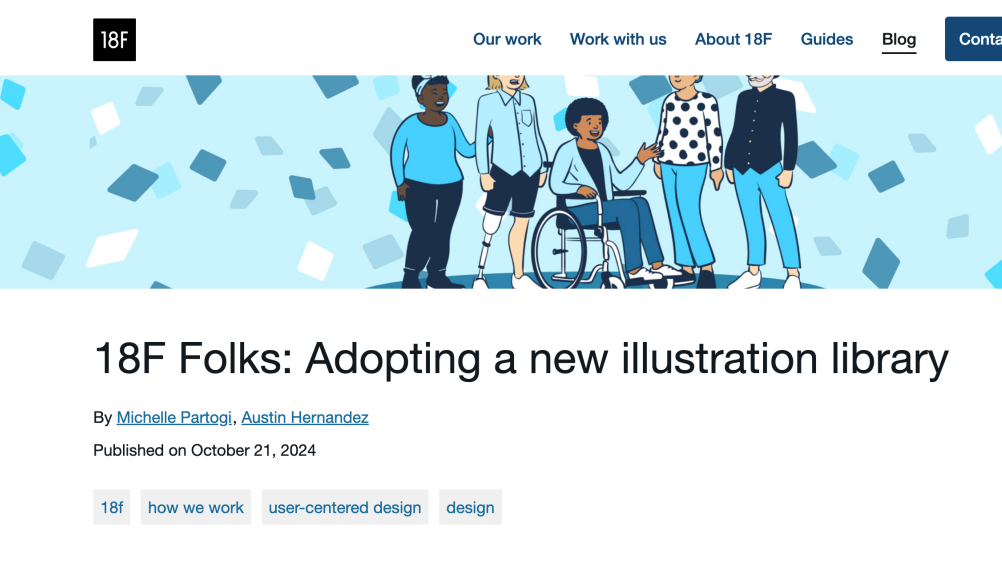Building Bridges: The Power of IT-Digital Service Collaboration in Arizona’s Government Service Delivery
To kick off the Digital Service Network’s (DSN) summer event series, Let’s Get Digital, the DSN heard from the State of Arizona on their efforts to transform government services through a strong collaboration between information technology (IT) and digital service functions.

To kick off the Digital Service Network’s (DSN) summer event series, Let’s Get Digital, the DSN heard from the State of Arizona on their efforts to transform government services through a strong collaboration between information technology (IT) and digital service functions. Under the leadership of State Chief Information Officer (CIO) J.R. Sloan and Digital Solutions Director Anebi Agbo, Arizona is modernizing its digital ecosystem with a focus on modular project management and agile procurement. This relationship is key to unifying and enhancing the state’s digital service delivery.
As CIO, Sloan oversees technology, innovation, development, and IT policies. Agbo joined the Arizona Strategic Enterprise Technology (ASET) Office in early 2024 and leads the newly established Digital Solutions Office (DSO), which focuses on creating integrated and personalized digital experiences.
Arizona’s Journey Toward Human-Centered Design and User Experience
Sloan spoke about a crucial initial project that sparked Arizona’s journey toward prioritizing human-centered design (HCD) and enhancing user experience (UX). The project, known as the Arizona Business One-Stop, was one of Sloan’s first attempts at cross-agency collaboration in his role as state CIO and serves as a backdrop for the State’s current commitment to unifying digital services. The project aimed to streamline processes and provide seamless digital service experiences for Arizona residents. Throughout its life cycle, it touched various agencies within the state, highlighting the benefits of collaboration and innovation across government service teams.
The journey, however, was not without challenges—the onset of the COVID-19 pandemic brought significant disruptions, including stalled funding and shifting priorities. Despite setbacks, frontline engagement in UX and HCD remained essential. Incorporating testing and user input played a key role in the project’s success, highlighting the value of a user-centered approach to deliver services that truly work for end users.
Fast forward to today, under a new administration, there has been a renewed investment in HCD and an emphasis on improving project management discipline. Procurement processes are being re-evaluated to incorporate creative and efficient solutions. This strategic focus aims to modernize Arizona’s digital experience with a strong emphasis on UX and customer experience (CX). Leading this charge is Agbo who, having spent most of his career working on various digital experiences—websites, design systems, and custom software—across industries, had not previously considered a career in government. However, upon seeing the opening for an innovative, new digital solutions role, he recognized the opportunity to bring his digital expertise to the public sector and contribute to meaningful change.
Current Goals
Agbo underscored the DSO’s core focus as evolving the State of Arizona’s digital ecosystem with an “obsession” for HCD. The goal is to build and orient digital services around the needs of Arizona residents. This involves rethinking traditional, program-heavy models and adopting more projectized, modular approaches by cultivating strong relationships across digital service and IT teams. Implementing faster feedback cycles enables the State to iterate, learn, apply tweaks, course-correct, and redo as necessary, thereby ensuring continuous improvement and responsiveness to user needs.
The Digital Solutions Office’s Four Pillar Approach
Arizona government is a federated environment—120 agencies, boards, and commissions comprise the executive board. The DSO sits within the Enterprise Programs & Consulting area and is focused on enabling integrated and personalized digital experiences that empower and improve the lives of individuals, businesses, and visitors to Arizona. Some of the DSO’s primary goals—known as “Phase Zero Objectives”—include engaging with other jurisdictions and agency stakeholders to learn applicable best practices and relevant support needs, building a private and public-sector talent pool, and exploring opportunities to advance design, product management, and agile procurement. Agbo spoke on some of the major challenges the DSO combats across the federated environment, such as siloed design standards, disparate procurement approaches, and a lack of cohesion in business application deployments. To address these problem areas, the DSO is prioritizing four pillars: product management, HCD, agile procurement, and digital innovation. By focusing on these critical pillars, the DSO is simultaneously addressing existing siloes and paving the way for a more agile, user-centered digital ecosystem.
Key Takeaways
- Cultivating strong digital service-IT relationships. Agbo and Sloan both view the digital service-IT relationship as mutually beneficial, where increased research into UX directly feeds into more successful service implementations. They prioritize the importance of working in lockstep to emphasize HCD strategy, recognizing that close collaboration between these teams strengthens their ability to deliver user-focused solutions.
- Building a cohesive, unified front. Agbo and Sloan emphasized the importance of creating unified project and design approaches across all state agencies. By fostering strong relationships between the DSO, other agencies, and their respective IT teams, they are breaking down silos that are common to the federated environment and ensuring that all departments work toward shared goals. This cross-agency alignment is crucial for delivering seamless and efficient digital services.
- Leveraging communities of practice. DSO aims to create a cross-functional community of practice, bringing together product, design, and engineering teams to collectively solve challenges and break down inter-agency siloes. Collaboration among these service teams allows for nuanced discussions on issues like UX, agile procurement, and artificial intelligence (AI). Agbo highlighted the importance of reassessing and doubling down on needs-based assessments and polls to prioritize end-user needs.
- “Sell the sizzle, not the steak.” Agbo spoke on the value of human-centered strategy and stressed the importance of focusing on desired outcomes and working backward to achieve them. This approach involves highlighting the benefits and impacts of a project in addition to the technical details. Agbo underlined the necessity of building trust and rapport in relationships across multiple agencies to ensure successful collaboration and project implementation.
- De-risking projects. Agbo and Sloan discussed the importance of incrementally checking in on projects to identify opportunities for course correction. They advocated for incorporating regular check-ins into agile procurement language and request for proposals (RFPs) to build flexibility and responsiveness, as well as pausing or stopping projects early if they are not meeting goals and standards, to avoid significant sunk costs down the line.
Conclusion
The event underscored the significant progress toward unifying Arizona’s digital services via HCD and agile project management. Agbo and Sloan shared insights into their collaborative efforts to align IT with HCD and digital innovation. By fostering a culture of continuous improvement and prioritizing HCD, Arizona is setting a new standard for digital government services. The commitment to modernization, efficiency, and user experience remains at the forefront, driving the State of Arizona toward a more connected future.
Watch the webinar and explore the resources and artifacts in the Digital Government Hub Library:
Related Content
Recommendation Matrix Template
A template recommendation matrix from the State of Arizona’s Digital Solutions Office.
State of Arizona Strategic Enterprise Technology Organizational Chart
Organizational chart for the State of Arizona Strategic Enterprise Technology (ASET).


